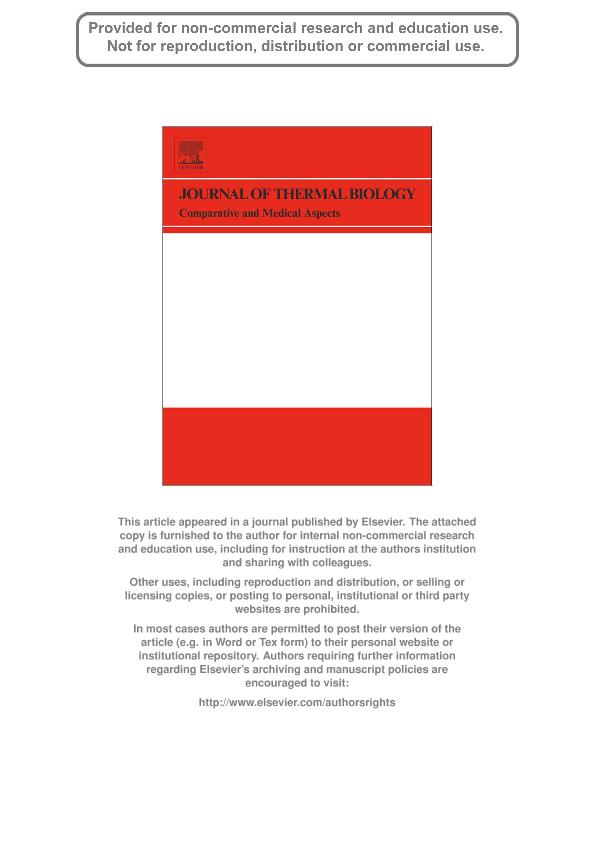Mostrar el registro sencillo del ítem
dc.contributor.author
Iungman, Josefina Luciana

dc.contributor.author
Piña, Carlos Ignacio

dc.date.available
2017-06-23T19:41:00Z
dc.date.issued
2013-05
dc.identifier.citation
Iungman, Josefina Luciana; Piña, Carlos Ignacio; Hypoxia and temperature: does hypoxia affect caiman embryo differentiation rate or rate of growth only?; Elsevier; Journal of Thermal Biology; 38; 7; 5-2013; 407-418
dc.identifier.issn
0306-4565
dc.identifier.uri
http://hdl.handle.net/11336/18795
dc.description.abstract
In crocodilians, the rate of embryonic development and consequently many posthatch attributes are affected by temperature. Since temperature exhibits strong influences on fitness (embryo survivorship and phenotype) by shaping development, we manipulated oxygen concentration in order to uncouple the effects of developmental rate from the direct effects of temperature. Here we consider whether oxygen constrains either differentiation rate (progression from one stage to the next) or embryonic growth (size). Thus, we incubated Caiman latirostris eggs at various oxygen concentrations, and at two temperatures (31 °C, 100% female-producing temperature, and 33 °C, 100% male-producing temperature). We monitored the developmental stages of these embryos within the thermosensitive period (stages 20–24), and assessed several physiological and morphological hatchling traits. While embryonic size was strongly influenced by oxygen, differentiation rate did not seem to be affected. Very low oxygen concentrations and high temperatures inhibited embryo survival. In addition, oxygen availability affected incubation period and hatchling size, whereas temperature did not cause a significant variation in hatchling size. By investing energy in differentiation hypoxic embryos decreased their size.
dc.format
application/pdf
dc.language.iso
eng
dc.publisher
Elsevier

dc.rights
info:eu-repo/semantics/openAccess
dc.rights.uri
https://creativecommons.org/licenses/by-nc-nd/2.5/ar/
dc.subject
Crocodylia
dc.subject
Caiman Latirostris
dc.subject
Incubation
dc.subject.classification
Biología del Desarrollo

dc.subject.classification
Ciencias Biológicas

dc.subject.classification
CIENCIAS NATURALES Y EXACTAS

dc.title
Hypoxia and temperature: does hypoxia affect caiman embryo differentiation rate or rate of growth only?
dc.type
info:eu-repo/semantics/article
dc.type
info:ar-repo/semantics/artículo
dc.type
info:eu-repo/semantics/publishedVersion
dc.date.updated
2017-06-23T18:12:35Z
dc.journal.volume
38
dc.journal.number
7
dc.journal.pagination
407-418
dc.journal.pais
Países Bajos

dc.journal.ciudad
Ámsterdam
dc.description.fil
Fil: Iungman, Josefina Luciana. Universidad Nacional del Litoral. Facultad de Humanidades y Ciencias; Argentina. Provincia de Entre Ríos. Centro de Investigaciones Científicas y Transferencia de Tecnología a la Producción. Universidad Autónoma de Entre Ríos. Centro de Investigaciones Científicas y Transferencia de Tecnología a la Producción. Consejo Nacional de Investigaciones Científicas y Técnicas. Centro Científico Tecnológico Conicet - Santa Fe. Centro de Investigaciones Científicas y Transferencia de Tecnología a la Producción; Argentina. Proyecto Yacaré; Argentina
dc.description.fil
Fil: Piña, Carlos Ignacio. Provincia de Entre Ríos. Centro de Investigaciones Científicas y Transferencia de Tecnología a la Producción. Universidad Autónoma de Entre Ríos. Centro de Investigaciones Científicas y Transferencia de Tecnología a la Producción. Consejo Nacional de Investigaciones Científicas y Técnicas. Centro Científico Tecnológico Conicet - Santa Fe. Centro de Investigaciones Científicas y Transferencia de Tecnología a la Producción; Argentina. Universidad Nacional de Entre Ríos; Argentina. Proyecto Yacaré; Argentina
dc.journal.title
Journal of Thermal Biology

dc.relation.alternativeid
info:eu-repo/semantics/altIdentifier/url/http://www.sciencedirect.com/science/article/pii/S0306456513000697
dc.relation.alternativeid
info:eu-repo/semantics/altIdentifier/doi/http://dx.doi.org/10.1016/j.jtherbio.2013.05.003
Archivos asociados
